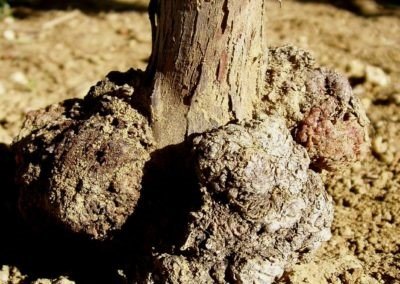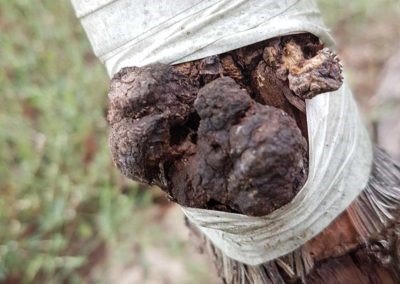Galls on vines, sometimes of spectacular size, are due to the Agrobacterium genus, which is widespread in soils and plant material. They only cause significant damage in particular situations linked to stress (heavy frosts, wounds, etc.).
2.4.2.i Crown Galls
What damage is caused by crown galls in the vineyard?
These burrs, specifically crown galls or trunk galls, are caused by a soil bacterium, Agrobacterium vitis, which is frequently found in the vascular system of the vine, where it usually remains without causing any visible problems.
In the event of wounds, often following severe winter frosts, but also due to pruning, grafting or overgrafting, hail damage or impacts linked to canopy management, Agrobacterium can cause the development of sometimes spectacular tumours.
Galls can be circular and form a continuous cordon around the trunk or an arm, blocking sap circulation and eventually causing its decline or death, or they can form a string of tumours, for example, along a trunk split by frost. There are also reports in the literature of root necrosis, particularly in young vines. They are usually found in countries affected by severe winter frosts (Eastern Europe, Canada, etc.).
What is the bacterium responsible for galls? What is its biology?
The process is now well documented: it is a natural genetic transformation. Agrobacterium introduces a fragment of its DNA, located in one of its plasmids (a small circular chromosome), into the genome of vine cells. Certain molecules synthesized following wounds appear to be able to trigger the plasimds' virulence genes and activate their insertion.
Tissue destruction also favours cell invasion by bacteria present in the vessels. The introduction of this bacterial DNA fragment into the genome of the cambium cells causes their autonomous anarchic growth, and induces the synthesis of nutritive substances used by the bacteria for their development. As a result, galls are formed locally, which are initially smooth and yellowish-green, and gradually become hollow and tuberous as they increase in size.
The natural abilities of this bacterial genus have been widely used in laboratories to transfer genes into various organisms, in particular to transform plants. In this case, the plasmid involved undergoes modifications that prevent gall formation, but allow the transfer of the relevant genes into the target genome.
Are there any preventive methods?
When pruning vines showing symptoms, it is advisable to disinfect the pruning shears (with bleach for example) as often as possible, as propagation by tools, as well as by weeping from the vines, has been proven. However, since these soil bacteria are widely present in all vineyards, and symptom onset is linked to specific stress situations, these measures have a very limited scope.
What treatments are available? How and when should they be applied?
The most common method is to take advantage of the bactericidal properties of copper by spraying or applying Bordeaux mixture to affected vines immediately following pruning and prior to budburst.
Extract from Vigne Vin Occitanie.



